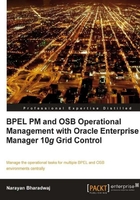
The introductory chapter contains basic information that is a prerequisite for the other chapters. You can dive into the other chapters on a need basis, based on what you would like to accomplish. All chapters have a problem statement defined, along with a summary of the solution provided. The solution itself is a step-by-step walkthrough on how to accomplish certain tasks to solve the problem.
The book is divided into three sections. The first section covers the management of BPEL Process Manager with Grid Control. The second section focuses on management of SOA Suite in general. The third section covers management of Oracle Service Bus.
Chapter 1, Grid Control, BPEL, and OSB Overview, gives a basic introduction to Grid Control that includes download, installation, and basic configuration. This is the foundation technology that provides the infrastructure for managing various targets from a single console.
Chapter 2, Discovering BPEL PM, talks about the discovery and configuration of the BPEL Process Manager target. Discovery of BPEL PM as a Grid Control-managed target is the first step before performing other management tasks.
Chapter 3, BPEL Process Monitoring, talks about viewing deployed BPEL processes and their constituent partner links. It goes on to talk about monitoring of BPEL processes and partner links using a combination of metrics and synthetic tests.
Chapter 4, BPEL Infrastructure Management, describes how to manage the underlying infrastructure components such as BPEL Process Manager server, dehydration database, Application Server, host, and so on. Administrators can manage several disparate systems in groups, reducing the time to detect the root cause of system-related problems.
Chapter 5, BPEL Service-Level Management, describes how to set service-level expectations for BPEL Processes, partner links, and tracking those levels through various metrics. This enables the service providers to monitor agreed-upon contractual guarantees with service consumers.
Chapter 6, BPEL Services Dashboard, illustrates that dashboards are important to visualize service-level performance and metrics for key services. This chapter also walks through how to construct a simple dashboard to show all critical services, and their top metrics, including service levels. Operations typically use this to keep a ready eye on services and act on any deviations from expected SLAs.
Chapter 7, BPEL Deployment Automation, shows deployment of BPEL artifacts is a repetitive and time-consuming task. This chapter describes how to deploy BPEL artifacts to multiple servers in an automated fashion. This ensures deployments are conducted in an error-free manner, and reduces overall scheduled downtime.
Chapter 8, BPEL Configuration Management, describes how to manage the configuration settings of the BPEL infrastructure, including setting baselines, and comparisons. This helps to diagnose problems due to configuration changes as well as standardize configurations across the enterprise.
Chapter 9, SOA Suite Cloning, discusses cloning as a complex administrative task that needs deep product expertise. This chapter walks through a simple scenario to clone an existing SOA Suite from one instance to another. Administrators can use this to perform critical time-consuming tasks in a standardized, error-free manner.
Chapter 10, Web Application Monitoring, describes how to set and monitor Web services using Grid Control service models, SLA rules, and synthetic tests. Web applications can also be monitored—including the recording and playback of HTTP(s) transactions to troubleshoot problems. Application administrators can proactively monitor applications from an end-user perspective.
Chapter 11, Discovery of WebLogic and OSB targets, talks about managing multiple WebLogic domains and OSB instances from a single console, as it is a frequent problem for the middleware administrator. Middleware administrators can use a single console to manage all their installations, perform complex management tasks, and dive into their respective WebLogic or OSB console to perform administrative activities. All of this enables the administrator to standardize management tasks, and hence the behavior of WebLogic and OSB servers, leading to increased uptime.
Chapter 12, OSB Deployment Automation, discusses that deployment of OSB projects and resources to multiple domains can be cumbersome and time consuming. This chapter walks through typical deployment scenarios and how they can be automated using the deployment procedure framework. This enables infrastructure teams to standardize deployments, as well as to track and manage artifacts centrally.
Chapter 13, OSB Proxy and Business Service Monitoring, walks the reader through Oracle Service Bus services that provide a versatile frontend plumbing layer to standardize messages from various sources and differing formats. Any performance bottleneck directly relates to a slowdown in critical backend business processes. This chapter also covers the monitoring capabilities for OSB proxy and business services. These provide the administrator with visibility into the runtime behavior, and take proactive steps to maintain a high-performing environment.
Chapter 14, WebLogic and OSB Configuration Management, describes that configuration changes are a major cause of downtimes in production environments. This chapter also covers WebLogic and OSB configuration tracking, viewing changes, and comparing and saving configurations. This enables administrators to resolve problems quickly and standardize a set of configurations across the enterprise.